Scottish household survey 2015: annual report
Report presenting reliable and up-to-date information on the composition, characteristics and behaviour of Scottish households.
6 Finance
6.1 Introduction and Context
The Scottish Government's approach to tackling poverty, reducing income inequality and increasing financial inclusion is set out in the Child Poverty Strategy for Scotland Our Approach 2014-2017 [44] which focuses on three key outcomes:
- Maximising household resources - With an aim to reduce income poverty and material deprivation by maximising financial entitlements and reducing pressure on household budgets among low income families, as well as by maximising the potential for parents to increase family incomes through good quality, sustained employment, and promoting greater financial inclusion and capability (Pockets).
- Improving children's wellbeing and life chances - With an aim to break inter-generational cycles of poverty, inequality and deprivation. This requires a focus on tackling the underlying social and economic determinants of poverty and improving the circumstances in which children grow up - recognising the particular importance of improving children's outcomes in the early years (Prospects).
- Children from low income households live in well-designed, sustainable places - With an aim to address area-based factors which currently exacerbate the effects of individual poverty for many families by continuing to improve the physical, social and economic environments in local areas, particularly in those areas of multiple deprivation in which child poverty is more prevalent (Places).
The SHS also includes brand new questions on parental and child material deprivation. This data has been collected since 2014 and is asked of one-third sample. Due to the complexity of these questions, and the fact that this is a new question set in the survey, thorough quality assurance is required. The national-level analysis based on the 2014 and 2015 data will be available in spring 2017. The 2016 national-level data will be presented in the annual SHS report, followed by an analysis for all local authorities later in the year.
Main Findings
The proportion of households reporting that they manage well financially, increased from 52 per cent in 2014 to 55 per cent in 2015.
Single parent and single adult households were most likely to report that they do not manage well financially with around a fifth (23 and 17 per cent, respectively) reporting they do not manage well financially - higher than the overall Scotland figure of 10 per cent.
Households in the social rented sector were the least likely to say they were managing well (29 per cent) which is in contrast to owner occupiers and the private rented sector where 68 per cent and 43 per cent, respectively, reported that they were managing well.
The percentage of households reporting having savings of £1,000 or more increased from 43 per cent in 2009 to 55 per cent in 2015.
Households with a net annual income of up to £20,000 are more likely not to have any savings when compared to all households (34 and 23 per cent respectively). Only one in ten households (ten per cent) with income over £30,000 reported having no savings.
Over a half (59 per cent) of single parent households reported having no savings, more than double than the overall Scotland figure of 22 per cent.
Around a half (52 per cent) of households in the social rented sector reported having no savings, compared to a third in the private rented sector (34 per cent) and less than one in ten of owner occupiers (8 per cent).
6.2 How Households are Managing Financially
The SHS asks respondents to rate how they feel their households have coped financially over the last year. The trend since 1999 (when the survey started) is shown in Figure 6.1 below.
Between 1999 and 2007 there was a general increase in the proportion of households that reported positively about their household finances, rising from 42 per cent of households in 1999 to more than a half (53 per cent) in 2007. Between 2007 and 2010 this proportion fell to around a half of all households and remained stable until 2013. As in 2014, in 2015 there was an increase in the number of households reporting they were managing well with over a half (55 per cent) of households saying they managed very or quite well, increasing from 48 per cent in 2013 and 52 per cent in 2014. The proportion of households that don't manage very well and have some financial difficulties decreased by three per cent since its high in 2012 (12 per cent).
Figure 6.1: How the household is managing financially this year
1999-2015 data, Households (minimum base: 3,660)
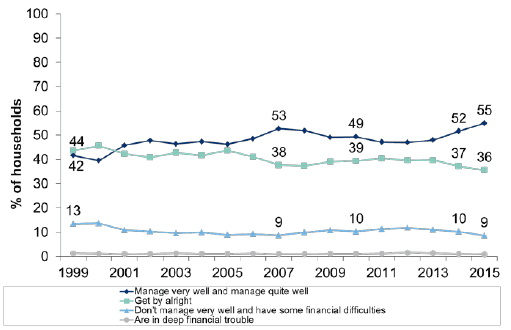
This question was only asked between January and March in 2003.
Figure 6.2 shows the household perceptions of how they manage financially varies by household income. Households on lower incomes (up to £20,000) were as likely to say that they manage well as they were to say that they get by (43 and 42 per cent respectively). However, one in five (21 per cent) of households on incomes up to £10,000 said they did not manage well - much higher than those on higher incomes.
There is a large gap between households with incomes over £30,000 and those below £30,000 - nearly three quarters (72 per cent) of all households with incomes over £30,000 reported managing well which is 16 percentage points higher than households with annual net income of £20,001 to £30,000 and 32 percentage points higher than households on the lowers incomes up to £10,000.
Figure 6.2: How the household is managing financially this year by net annual household income
2015 data, Households (minimum base: 1,180)
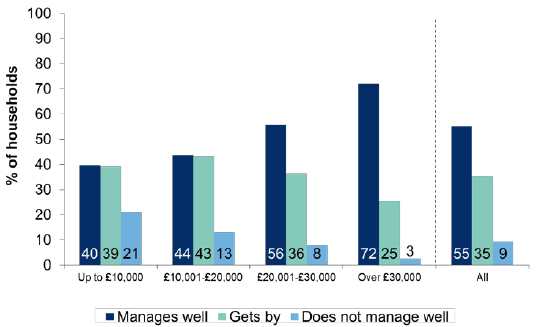
Table 6.1 shows how perceptions of management of household finances varied by household type. Single parent households were the most likely to report that they were not managing well financially with almost a quarter (23 per cent) saying they are not managing well financially - this is more than double the proportion of all households in Scotland at 10 per cent. Another group above the Scotland average were single adult households with around one in six (17 per cent) reporting that they were not managing well financially.
Table 6.1: How the household is managing financially this year by household type
Column percentages, 2015 data
| Households | Single adult | Small adult | Single parent | Small family | Large family | Large adult | Older smaller | Single older | All |
|---|---|---|---|---|---|---|---|---|---|
| Manages well | 44 | 61 | 23 | 53 | 42 | 60 | 68 | 64 | 55 |
| Gets by | 39 | 31 | 55 | 39 | 47 | 31 | 28 | 33 | 36 |
| Does not manage well | 17 | 8 | 23 | 9 | 11 | 8 | 4 | 3 | 10 |
| Total | 100 | 100 | 100 | 100 | 100 | 100 | 100 | 100 | 100 |
| Base | 1,980 | 1,890 | 560 | 1,290 | 580 | 880 | 1,500 | 1,570 | 10,250 |
Perceptions of financial management are also associated with household tenure, as shown in Figure 6.3. Around two-thirds (68 per cent) of owner occupiers reported managing well - more than double the proportion of households in social rented properties saying the same (29 per cent). Around one-in-five (22 per cent) social rented households reported not managing well which is more than double the rate of all households in Scotland (10 per cent). By contrast, only 14 per cent in the private rented sector and 4 per cent in the owner occupied sector reported that they were not managing well financially.
Figure 6.3: How the household is managing financially this year by tenure of household
2015 data, Households (minimum base: 130)
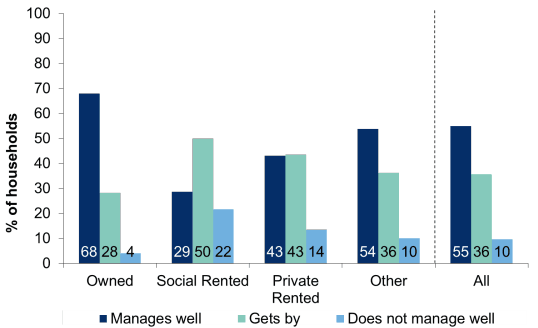
Table 6.2 shows how households were managing financially by their main income source. Households relying mainly on benefits (which includes recipients of the state pension) were the most likely to say they are not managing well with around a sixth (16 per cent) reporting that they were not managing well. Conversely only seven per cent of households relying on earnings and four per cent of households relying on other sources [45] reported that they were not managing well.
Table 6.2: How the household is managing financially this year by income sources
Column percentages, 2015 data
| Households | Main income from earnings | Main income from benefits | Main income from other sources | All |
|---|---|---|---|---|
| Manages well | 59 | 43 | 76 | 55 |
| Gets by | 35 | 42 | 20 | 35 |
| Does not manage well | 7 | 16 | 4 | 9 |
| Total | 100 | 100 | 100 | 100 |
| Base | 5,500 | 3,330 | 1,080 | 9,930 |
Households where the Highest Income Householder ( HIH) was male were more likely to say they do manage well (Table 6.3) with almost three fifths saying so compared to a half of households where the highest income householder was female (59 per cent, compared with 50 per cent). Increasing age of the highest income householder is also associated with a higher percentage of households reporting that they were managing well.
Table 6.3: How the household is managing financially this year by sex and age of highest income householder
Column percentages, 2015 data
| Households | Male | Female | 16 to 24 | 25 to 34 | 35 to 44 | 45 to 59 | 60 to 74 | 75 plus | All |
|---|---|---|---|---|---|---|---|---|---|
| Manages well | 59 | 50 | 44 | 50 | 48 | 51 | 63 | 69 | 55 |
| Gets by | 33 | 39 | 43 | 39 | 38 | 37 | 32 | 30 | 36 |
| Does not manage well | 8 | 11 | 13 | 12 | 14 | 12 | 5 | 2 | 10 |
| Total | 100 | 100 | 100 | 100 | 100 | 100 | 100 | 100 | 100 |
| Base | 6,000 | 4,250 | 430 | 1,260 | 1,590 | 3,020 | 2,590 | 1,360 | 10,250 |
There are high levels of perceived financial difficulty in areas of deprivation (Table 6.4). More than double the proportion of households in the 20 per cent most deprived areas of Scotland said they were not managing well financially (18 per cent), compared with households in the rest of Scotland (seven per cent).
Table 6.4: How the household is managing financially this year by Scottish Index of Multiple Deprivation [46]
Column percentages, 2015 data
| Households | 20% Most Deprived | Rest of Scotland | Scotland |
|---|---|---|---|
| Manages well | 35 | 60 | 55 |
| Gets by | 47 | 33 | 36 |
| Does not manage well | 18 | 7 | 10 |
| Total | 100 | 100 | 100 |
| Base | 1,890 | 8,360 | 10,250 |
6.3 Savings and Investments
Prior to 2009, information on savings or investments was asked via two questions. From January 2009 questions on savings were consolidated into a single question asking whether the highest income householder and their spouse or partner had savings of £1,000 or more, less than £1,000 or no savings or investments. This means that data prior to 2009 is not comparable with later data
This new, single question resulted in a higher proportion of people reporting that they had savings and investments (when compared to the old questions). This apparent change is more likely to be the result of respondents' perceptions of what constituted savings and investments before. For example, under the old question, a respondent may have had savings of less than £1,000 but answered 'no' to the question on whether they had savings and investments if they perceived this amount to be too low. Table 6.5 shows figures about whether SHS respondents had savings or investments from 2009 (when the new, consolidated question was introduced). Over this period, the percentage of households reporting having savings of £1,000 or more increased by 12 percentage points, from 43 per cent in 2009 to 55 per cent in 2015.
Table 6.5: Whether respondent or partner has any savings or investments by year
Column percentages, 2009-2015 data
| Households | 2009 | 2010 | 2011 | 2012 | 2013 | 2014 | 2015 |
|---|---|---|---|---|---|---|---|
| No savings | 25 | 29 | 27 | 26 | 24 | 25 | 22 |
| Has savings | 61 | 60 | 63 | 65 | 67 | 68 | 70 |
| Less than £1,000 | 18 | 12 | 12 | 15 | 16 | 15 | 15 |
| £1,000 or more | 43 | 48 | 51 | 50 | 51 | 53 | 55 |
| Don't know | 2 | 1 | 1 | 1 | 1 | 1 | 1 |
| Refused | 12 | 9 | 9 | 9 | 7 | 6 | 7 |
| Total | 100 | 100 | 100 | 100 | 100 | 100 | 100 |
| Base | 10,320 | 11,000 | 10,790 | 3,460 | 3,510 | 3,530 | 3,480 |
Note: Question asked only of a 1/3 sample from 2012
Figure 6.4 shows how the level of household savings varied by net annual household income in 2015. Households with a net annual income of up to £20,000 were more likely not to have any savings when compared to all households (34 and 23 per cent respectively). Only one in ten households (ten per cent) with income over £30,000 reported having no savings.
Figure 6.4: Whether respondent or partner has any savings or investments by net annual household income
2015 data, Households (minimum base: 410)
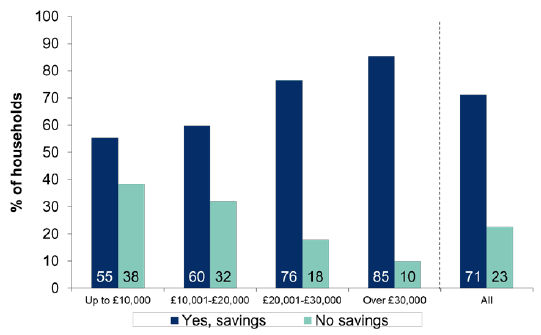
Please note that the 'All' figures may differ slightly from Table 6.5 due to missing income information.
Household type also shows some variation on whether a household has savings, as shown in Figure 6.5. Single parent and single adult households were more likely to report having no savings (59 per cent and 34 per cent, respectively) when compared to all households (22 per cent). Around a third of large families had no savings in 2015 (31 per cent), while a quarter of small families reported not having any savings (25 per cent). Older smaller households were most likely to have savings (83 per cent).
Figure 6.5: Whether respondent or partner has any savings or investments by household type
2015 data, Households (minimum base: 170)
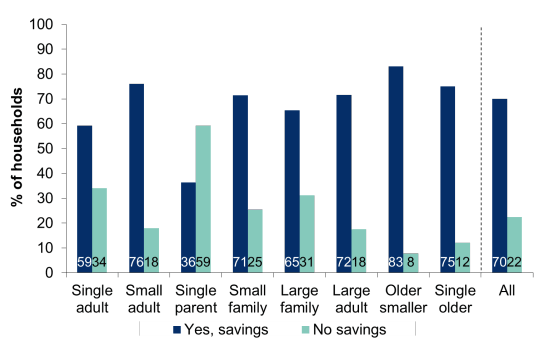 As shown in Table 6.6, levels of savings and investments vary by the tenure of households with owner occupiers much more likely to report having savings (84 per cent) when compared to the overall Scotland figure (70 per cent). Conversely, just over a half of all social rented households reported having no savings (52 per cent) which is more than double the proportion of all households in Scotland (22 per cent). This compares to a third (34 per cent) in the private rented sector reporting having no savings, and less than one in ten of owner occupiers (8 per cent).
As shown in Table 6.6, levels of savings and investments vary by the tenure of households with owner occupiers much more likely to report having savings (84 per cent) when compared to the overall Scotland figure (70 per cent). Conversely, just over a half of all social rented households reported having no savings (52 per cent) which is more than double the proportion of all households in Scotland (22 per cent). This compares to a third (34 per cent) in the private rented sector reporting having no savings, and less than one in ten of owner occupiers (8 per cent).
Table 6.6: Whether respondent or partner has any savings or investments by tenure of household
Column percentages, 2015 data
| Households | Owned | Social Rented | Private Rented | Other | All |
|---|---|---|---|---|---|
| No savings | 8 | 52 | 34 | * | 22 |
| Yes, savings | 84 | 42 | 59 | * | 70 |
| Less than £1,000 | 10 | 21 | 26 | * | 15 |
| £1,000 or more | 73 | 20 | 34 | * | 55 |
| Dont know | 1 | 1 | 1 | * | 1 |
| Refused | 7 | 6 | 5 | * | 7 |
| Total | 100 | 100 | 100 | 100 | 100 |
| Base | 2,210 | 810 | 410 | 40 | 3,480 |
Table 6.7 shows how levels of household savings or investments varies by age and gender of the highest income householder. Households with older highest income householders were more likely to report having savings (80 per cent aged 60 to 74 compared to 70 per cent of all households). There is a relationship between having savings or investments and gender - households where the highest income householder is female were more likely to report having no savings (28 per cent) compared to males (18 per cent).
Table 6.7: Whether respondent or partner has any savings or investments by sex and age of highest income householder
Column percentages, 2015 data
| Households | Male | Female | 16 to 24 | 25 to 34 | 35 to 44 | 45 to 59 | 60 to 74 | 75 plus | All |
|---|---|---|---|---|---|---|---|---|---|
| No savings | 18 | 28 | 55 | 33 | 30 | 22 | 11 | 10 | 22 |
| Has savings | 74 | 64 | 43 | 63 | 65 | 70 | 80 | 76 | 70 |
| Less than £1,000 | 14 | 17 | 21 | 24 | 22 | 12 | 12 | 9 | 15 |
| £1,000 or more | 61 | 47 | 23 | 39 | 44 | 58 | 68 | 67 | 55 |
| Don't know | 1 | 1 | - | 1 | 1 | 1 | 1 | 1 | 1 |
| Refused | 6 | 7 | 2 | 3 | 4 | 7 | 7 | 13 | 7 |
| All | 100 | 100 | 100 | 100 | 100 | 100 | 100 | 100 | 100 |
| Base | 2,060 | 1,420 | 160 | 390 | 500 | 1,040 | 920 | 460 | 3,480 |
6.4 Banking
The SHS has asked about bank or building society accounts annually since 1999, with more details collected on Credit Unions and Post Office accounts since January 2007. These questions were reduced in scope to be asked of one-third of the sample in 2012.
Table 6.8 shows how the proportion of households with a bank or building society account changed between 2009 to 2015. The proportion of households where neither the respondent nor their spouse or partner had a bank or building society account fell from 12 per cent in 1999 to 4 per cent in 2009. Since then it has remained stable with only around 3 per cent of households reporting having no bank or building society account.
Table 6.8: Whether respondent or partner has a bank or building society account by year
Column percentages, 2009-2015 data
| Households | 1999 | 2009 | 2010 | 2011 | 2012 | 2013 | 2014 | 2015 |
|---|---|---|---|---|---|---|---|---|
| Yes | 86 | 93 | 92 | 93 | 93 | 95 | 95 | 94 |
| No | 12 | 4 | 4 | 4 | 4 | 3 | 3 | 3 |
| Refused | 2 | 3 | 4 | 3 | 3 | 3 | 2 | 3 |
| Base | 14,650 | 10,290 | 11,000 | 10,790 | 3,460 | 3,510 | 3,530 | 3,480 |
From January 2012, this question was asked of three quarters and one third of the sample, respectively.
This analysis excludes Credit Unions and Post Office accounts.
There is a clear pattern between not having a bank, building society or other account and levels of income and deprivation as shown in Table 6.9. Households with a smaller income were more likely to say they made use of banking facilities through the Post Office (seven per cent of those with an income up to £10,000 compared to two per cent with an income over £30,000). Households living in the 20 per cent most deprived areas of Scotland were less likely to have a bank account than the rest of Scotland (90 per cent compared to 94 per cent) or a building society account (nine per cent compared to 17 per cent).
Table 6.9: Whether respondent or partner has banking facilities by net annual household income and Scottish Index of Multiple Deprivation
Percentages, 2015 data
| Households | Up to £10,000 | £10,001 - £20,000 | £20,001 - £30,000 | Over £30,000 | 20% most deprived | Rest of Scotland | All |
|---|---|---|---|---|---|---|---|
| Bank account | 90 | 92 | 95 | 97 | 90 | 94 | 93 |
| Building Society account | 11 | 11 | 15 | 23 | 9 | 17 | 15 |
| Credit Union Account | 2 | 3 | 5 | 4 | 6 | 3 | 4 |
| Post Office Card Account | 7 | 6 | 3 | 2 | 7 | 3 | 4 |
| None of these | 2 | 1 | 1 | 0 | 2 | 1 | 1 |
| Refused | 2 | 3 | 2 | 2 | 3 | 3 | 3 |
| Base | 410 | 1,140 | 700 | 1,100 | 650 | 2,820 | 3,480 |
Columns may not add to 100 per cent since multiple responses were allowed.
Contact
Email: Jackie Horne
There is a problem
Thanks for your feedback